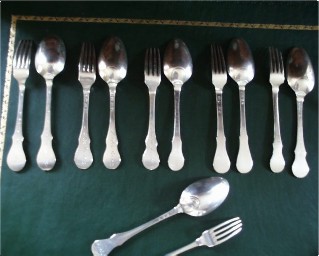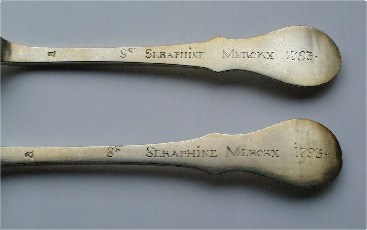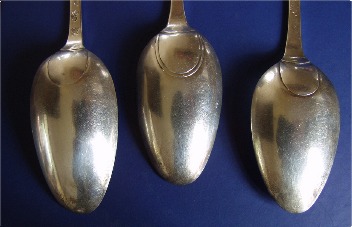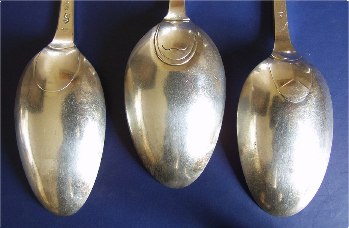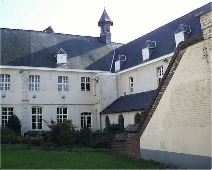click on images to enlarge
SILVERWARE FROM THE BLACK SISTERS OF PAMELE
The interest in flatware which I have had for several years has led
to a surprising discovery.
Having found several forks and spoons in an antique shop in the town
where I was born, my curiosity was piqued and I decided to make an
in-depth study of the theme.
The flatware all has the marks of the town of Audenaerde and can be
dated to the 18th century. The silversmiths who fashioned them can also
easily be identified.
In addition, on each piece there is a Christian name and surname,
preceded by the letters 'Sr', and followed by a date. These can only
refer to nuns, and later I discovered that the engraved date corresponds
to the year in which each nun made her vows of profession.
My investigation took me to the convents near to the town of Audenaerde,
and an old book provided the key to the mystery: 'Audenaerde et ses
monuments' written in 1913 by the Abbé Paul van de Vyvere.
The flatware is a testimony from the past and can be considered as a
document of historic value. It forms part of the history of the town of
Audenaerde.
Historic Notes
Formerly Audenaerde had two convents belonging to the 'Black
Sisters', the first in Audenaerde itself, and the second at Pamele
behind the Notre Dame church.
The foundation of the first convent, situated in the rue des Vignobles
or Wijngaertstraete, dates from 1295.
The sisters helped to cure the sick in their houses and their services
were appreciated above all in the Middle Ages when the Black Death swept
through all the communities around Audenaerde.
The nuns were twice striken with the furies of the iconoclasts, in 1566
and again in 1572.
Finally a large part of the convent's land and buildings were fortified
under the direction of Vauban.
At the request of the sisters, the local magistrates compensated them
with the Corporation of St Michel and the hospice of St Jacques along
with the chapel and dependencies all located in the rue d'Eyne.
Important changes were made, and in 1672 the sisters acquired the
property adjoining the rue des Chats or Kattestraete which they called
the 'audit Clooster ofte Tempeliershuys' .
The new chapel was consecrated on the 28th August, 1673, and dedicated
to their patron, St Augustine. The convent was suppressed by the French
Revolution on the 19th December, 1796.
The origin of the convent of the 'Black Sisters' at Pamele appears to
date from the same period as the foundation of the convent of the 'Black
Sisters' of Audenaerde and its construction dates to the same time as
the church of Pamele.
The nuns likewise had St Augustine as their patron saint and also
dedicated their activities to helping the sick.
Here too the Protestants ravaged the convent, but the real damage was a
result of the bombardment by French general d'Humières. The explosions
almost entirely destroyed the chapel and the early buildings. Precious
objects were buried in the rubble and the order's statues were consumed
in the flames.
The Convent of the 'Black Sisters' of Pamele was in ruins…
The convent was slowly reconstructed in stages and with long intervals,
as shown by the inscriptions we can see on the entrance arch (1638), in
front of the chapel (1684), and in the refectory (1715).
In the French Revolution, the convent was suppressed, but once the peace
was re-established the sisters returned to their ancient walls and,
along with the nuns of the Audenaerde, restarted their charitable works.
The chapel of the Convent of the 'Black Sisters' still preserved a good
number of gravestones, all in a good state of preservation.
In the centre of the floor in front of the choir there is one gravestone
showing a coat of arms with a cross and mitre above. It is the tomb of
André Chevrier, abbé of Corbie, who in 1667 took refuge in the convent
of Audenaerde and became the spiritual father of the community. In this
time, the director lived in the convent itself, although in a separate
building.
A large number of other epitaphs are in good condition and can be read.
Among them are several belonging to the nuns whose names are inscribed
on the spoons and forks stamped from Audenaerde.
· Sr Coletta Voet,took her vows in 1782 and died 13 April
1826 at the age of 69
· Sr Catharina van Wanzeele, took her vows in 1788 and
died in 1836 at the age of 73. Flatware marked Sr CvW
· Sr Rosa Blommaert, took her vows in 1780 and died in
1837at the age of 87
· Sr Barbara Herman, took her vows in 1767 and died in
1828 at the age of 88. Flatware marked Sr B H 1767
· Sr Bernadette Ghys, took her vows in 1776 and died in
1816 at the age of 66
· Sr Francisca (van) Heuvick, took her vows in 1790 and
died in 1842 at the age of 78
Description of the Flatware
1/ Town mark: Crowned A for Audenaerde Lunettes for Audenaerde
date stamp : crowned 84 for 1784
maker's mark : Monogram AvM for Anthone VAN DER MEERSCH 1736-1814
Personal inscription: Sr Coletta Voet 1782
In the chapel of the Convent of the “Black Sisters” there is the
following epitaph
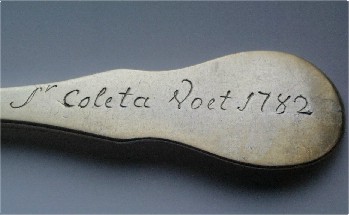
+
Memoire
Van Sr Coletta
Voet religieuse geprofest den 12 9bre
1782 overl , den 13
April 1826
oudt 69 jaeren
R.I.P.
|
2/ Town mark : Crowned A for Audenaerde Lunettes for
Audenaerde
date stamp: crowned 80 for 1780
maker's mark : Monogram AvM for Anthone VAN DER MEERSCH 1736-1814
Personal inscription: Sr Rosa Blommaert 1780
In the chapel of the Convent of the “Black Sisters” there is the
following epitaph:
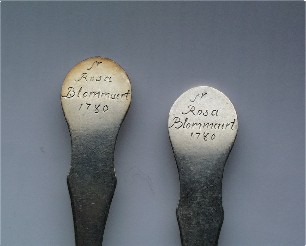
+
Memoire
Van Sr Rosa
Blommaert religieuse
geprofest den 3 febru
1780 overl den 13
8b
1837 9 j.jubilarice
oudt 87 jearen
|
3 / town mark :
date stamp:
maker's stamp : illegible
Personal inscription : Sr Francisca Van Heuvick 1790
In the chapel of the Convent of the “Black Sisters” there is the
following epitaph:
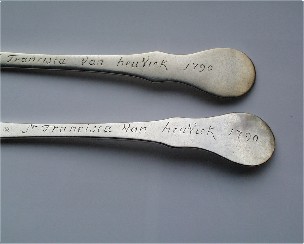
+
Memoire
Van Sr Francisca
Heuvick gheprofeste
religieuse de 17 Mey
1790 overleden den
14 Maert 1842 Jube oudt
78 jaer
R.I.P.
|
4/ town mark: crowned A for Audenaerde Lunettes for Audenaerde
Date stamp: crowned 67 for 1767
Maker's stamp : Monogram of the letters AvM for Anthone VAN DER MEERSCH
1736-1814
Personal inscription : Sr Bernarde Ghys 177 (possibly 1776)
In the chapel of the Convent of the “Black Sisters” there is the
following epitaph:
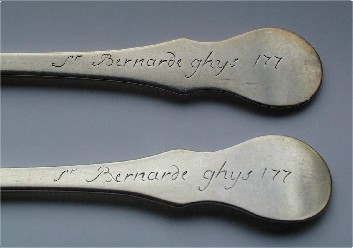
+
Memoire
van Sr Bernaerde
Ghys religieuse
geprofest den 21 Meye
1776 overl, den 20
Meye 1816
oudt 66 jaeren
R.I.P.
|
5/ town mark : crowned A for Audenaerde Lunettes for
Audenaerde
Date stamp: crowned 79
Maker's stamp: little monogram AvM
For Anthone VAN DER MEERSCH (1736-1814)
Personal inscription : Sr B H 1767
In the chapel of the Convent of the “Black Sisters” there is the
following epitaph:
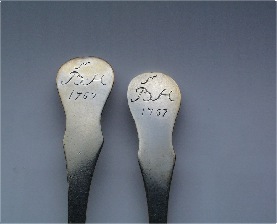
+
Memoire
van Sr Barbara
Herman religieuse
geprofest den 3 Juny
1767 overl, den 6 9b
1828 12 j. jubilarice
oudt 88 jaeren
R.I.P.
Through deduction, the flatware would seem to have belonged to Sr
Barbara Herman, initials B H, who took her vows in 1767, the date
inscribed in the piece.
|
6/ town mark :
date stamp:
maker's stamp : Master of sitting dog - unknown
IPersonal inscription : Sr Séraphine Merckx 1793
There is no epitaph to be found in the chapel of the 'Black Sisters' at
Audenaerde
Possibly these pieces belonged to a nun from the same congregation,
however her name is not found in the archives of the Black Sisters
convent.
The pieces are in very good condition, as if they were never used. The
maker is different from the maker of the other pieces described above. I
wonder if Séraphine Merckx left the convent early on, or perhaps was
from another order and took refuge in the Audenaerde community during
the troubled period of the French Revolution.
The Marks
  town
mark of Audenarde town
mark of Audenarde
|
 maker's
mark: AVM : Anthone van der Meersch maker's
mark: AVM : Anthone van der Meersch
|
 maler's
mark: Master of sitting dog (not identified) maler's
mark: Master of sitting dog (not identified)
|
 date
stamp with date beneath cown date
stamp with date beneath cown
|
Comparison of two of the spoons
Numerus clausus - Levée Etroite
We once more find the list of the « Black Sisters » in the population
register for 1795.
There are fourteen names on this list.
On a canvas, painted in 1698 and located in the refectory of the 'Black
Sisters' situated behind the church at Pamele, fifteen nuns are listed.
This leads us to suppose there was a closed number, or numerus
clausus, of sisters which had come into being over the years and
that this number was fixed at fifteen.
On a list of the inhabitants of the convent located at Smalendam, and on
official documentation dating from the French Occupation, we can find
the explanation of this 'Levée Etroite'.
1. Isabelle De Moor, zuster Augustinus, 57 j.
2. Petronella Dhoosche, zuster Monica, 75 j.
3. Isabelle Hespel, zuster Albertine, 81 j.
4. Jeanne Van de Lanotte, zuster Marie-Thérèse: 71 j.
5. Marie Boi, zuster Constance, 50 j.
6. Caroline Herman, zuster Barbara, 55 j.
7. Mare Van de Woestijne, zuster Jacoba, 50 j.
8. Jeanne Ghys, Zuster Bernarde, 40 j.
9. Elisabeth Blommaert, zuster Rosalia, 43 j.
10. Marie-Thérèse Voet, zuster Coleta, 38 j.
11. Isabelle Van Wansele, zuster Catharina, 34 j.
12. Philippine Buyse, zuster Antonia, 33 j.
13. Christine Uvick, zuster Francisca, 34 j.
14. Desideria Grude, zuster Angela, 28 j
Jeanne Commerce,41 j., dienstmeid
Thérèse De Vos, 73 j., dienstmeid
Marie Gabriels, 45 j. dienstmeid.
After the abolition of their convent during the French Occupation,
the 'Black Sisters' had to wait for better times before returning to
their convent.
When the right moment came, they were joined by the sisters from the
convent located in the town of Audenarde who likewise had gone through a
difficult period.
Once more they resumed the tradition of their order, helping the sick as
they had done for centuries. They continue their activities up to the
present, operating the clinics of the Sacred Heart and the Holy Family.
In the population list of Audenaerde dating from 1795, among the 14
names of the nuns, we find 6 who are present of the silver flatware.
Today the Zwarte Zusters, or “Black Sisters” of Pamelehave died out.
The last nuns, Sister Maria, Sister Godelieve and Sister Susanne passed
away about twelve years ago joining all those who had made the history
of this charming provincial convent.
On Reflection .......
I have walked to Pamele, behind the church, and there I have found a
charming small convent discretely hidden from immodest eyes to the rear
of the bell tower.
Of the convent, the historic walls still exist. Part of the site is now
occupied by a primary school, the rest by a religious group.
I hope the tower and the protective mantle of Our Lady continue to
protect this monastic heritage which has been here since the 13th
century.
And I reflect on some of Flemish verses to be found on walls all over
Flanders:
Daar alleen kan liefde wonen
Daar alleen is 't leven zoet
Waar men vrij en ongedwongen
Alles voor elkander doet.
|
Là seul peut demeurer l'amour
Là seul la vie est douce
Où libre et sans contrainte
On fait tout pour autrui
|
And also on those written by Georges Rodenbach:
J'aime les petites rues
Aux archaïques atours,
Pleines d'herbes incongrues
Et de puérils détours.
Je les aime déridées,
S'en allant d'un pas cassé,
Qui leur viennent du passé !
I will never be able to resist entering the small chapel and
rediscovering the epitaphs of the nuns whose names are inscribed on my
forks and spoons.
What will be my next discovery? Believe me, if one day, you find some
silver with crests, monograms, or perhaps even engraved with the names
of nuns, try to decipher their mystery, it's worth the effort.
And if you give them a little of your time, their memories will revive
and, in so doing, you will contribute to making history.
The convent of Sœurs Noires de Pamele The Curch Notre Dame de
Pamele
This is the English version from the original French, translated by
Patrick Vyvyan
|

